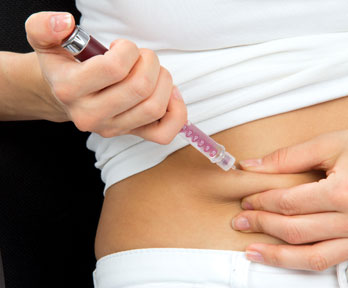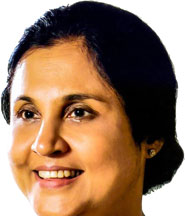Non
communicable but dangerous
With 25% Sri Lankan adults overweight, diabetes is a
spectre hovering over the lives of 1 in 3 over the age of 40:
by Carol Aloysius
 The spectre of diabetes has stalked adult populations across
continents for years. Today younger people including children, are
pre-diabetic or diabetic, and at risk of developing serious
complications early in life. Recent statistics indicate 15% of Sri
Lankan children are obese, while obesity among adults has also increased
three-fold in the past two decades with over 25% Lankan adults being
overweight. The spectre of diabetes has stalked adult populations across
continents for years. Today younger people including children, are
pre-diabetic or diabetic, and at risk of developing serious
complications early in life. Recent statistics indicate 15% of Sri
Lankan children are obese, while obesity among adults has also increased
three-fold in the past two decades with over 25% Lankan adults being
overweight.
Professor in Reproductive Medicine, Dept. of Obstetrics & Gynaecology,
Faculty of Medicine, University of Colombo, Dr Chandrika N. Wijeyaratne
shares with the Sunday Observer, current insights into the disease based
on her own hands-on experience in the field.
Excerpts...
Q: Diabetes Mellitus is one of the commonest diseases in Sri
Lanka. Yet many are unaware they have the disease? Why?
A: The reason most affected persons remain unaware of
increased blood sugar is because they do not experience any symptom
until the blood glucose becomes very high. Diabetes afflicts around 1 in
10 adults over 20 years of age and almost 1 in 3 among those above 40
years of age.
Q: How do you develop high blood sugar?
A: High blood sugar results from a relative lack of the
hormone insulin that drives the blood glucose into cells. The commonest
reason is a resistance of the body cells to the action of insulin that
is caused by unhealthy lifestyle and physical inactivity leading to
excess body fat. This is called Type 2 diabetes. When there is a
cellular level resistance to insulin, the pancreas that produces insulin
has to work 'overtime' to achieve an increased insulin production.
Eventually the pancreas becomes tired out and exhausted causing insulin
deficiency. When the body develops insulin resistance the blood sugar
tends to increase, particularly by excess production of glucose by the
liver. In parallel the blood cholesterol and fats (lipids) increase with
a tendency to develop high blood pressure.
|

Dr Chandrika N. Wijeyaratne |
High blood sugar has been observed to occur among Lankans at a
younger age. If a person in the late 20s develops type 2 diabetes, and
it remains undetected and uncontrolled, he could develop complications
of the disease before the age of 40 years.
The less common variety of Type 1 diabetes is often seen in the young
where there is destruction of the insulin producing cells of the
pancreas. This group of people often develop symptoms of passing large
amounts of urine with excess thirst, severe weight loss despite a good
appetite and may even be rushed to hospital with 'diabetic coma' caused
by acid like substances called ketone bodies produced by an increased
breakdown of body fat for energy. Diabetic ketoacidosis is life
threatening and requires emergency hospital treatment.
Q: Is diabetes inherited?
A: No doubt there is a genetic tendency to develop diabetes
when your family members are diabetic. But the primary and major
underlying cause of the common variety of Type 2 diabetes is an
unhealthy lifestyle and unhealthy environment causing excess body fat,
particularly around the waist.
Q: What are 'unhealthy lifestyles'?
A: Consuming excess unhealthy food with tobacco and alcohol
abuse, coupled with physical inactivity, contribute to weight gain, high
blood pressure, and the gradual damage to all blood vessels. Overweight
and obese persons don't become so overnight. Often the foundation is
laid in the mother's womb and during childhood, due to the wrong belief
that a 'chubby child' is healthier. This is absolutely wrong.
Q: Those most at risk?
A: Adolescents are at increased risk of developing insulin
resistance, especially during puberty. Children and young adults who
consume excess fast food, fizzy sugar laden drinks and spend long hours
at the computer or watching TV are at greater risk of becoming obese.
This results in pre-diabetes, which is just a single step ahead of
developing diabetes. Increasing age or a stressful event like surgery,
trauma or pregnancy can tip the balance and speed up the development of
diabetes in these high risk individuals. There are certain drugs such as
steroids that also increase this conversion to diabetes.
Q: How do you detect Diabetes?
A: Blood glucose testing is the modern day diagnostic. To
confirm diabetes you must check fasting blood sugar on two occasions to
ensure it remains high. The ideal method of testing is blood drawn into
a syringe, the plasma separated in the laboratory and tested for sugar.
This is accurate and cheap although its takes some time to know your
result. However, the glucometre is a handy tool to check your capillary
whole blood with a tiny drop of blood obtained by a needle prick of the
finger tip. Capillary blood glucose is about 15% less in value than
plasma glucose.
The gold standard test to confirm pre-diabetes or diabetes is the 75g
oral glucose tolerance test (OGTT). This requires overnight fasting of 8
hours and involves testing fasting blood glucose (FBG) and the 2 hour
post glucose BG. In pre-diabetes the FBG exceeds 100 and is less than
126 mg/dL or the 2 hour BG is between 140 and 200 mg/dL. To confirm
diabetes the FBG has to exceed 125 mg/dL or the 2hour value over 200 mg/dL.
Performing the OGTT requires resources and is laboratory based.
Therefore we often rely on FBG or random blood glucose (RBG) on two
separate occasions; RBG in excess of 200 mg/dL suggesting diabetes.
Another, but expensive test is the blood HbA1c% that reflects your
average blood sugar in the previous 3 months - the lifetime of a red
blood cell. In a normal non diabetic individual this test value should
be less than 6%.
Q: What organs are most affected by diabetes?
A: The triad of high blood sugar, high blood pressure and
elevated lipids leads to premature atheroma or fat filled blockage of
blood vessels that feed vital organs. Such complete blockage of blood
flow to the heart and brain cause heart attacks and strokes respectively
(Macro vascular disease). The smaller blood vessels of the kidney,
nerves and eye are affected by persistent high blood sugar that causes
Micro-vascular disease. The net result includes kidney failure, numb
feet with loss of protective sensation that increases risk of foot
injury and infection leading to leg amputation, sexual dysfunction and
blindness. So although high blood sugar causes few symptoms, it has it
has great potential to damage almost every organ of the body leading to
premature disability and death.
Q: Typical symptoms of diabetes?
A: The patient will lose weight, feel excessively tired, and
develop leg cramps at night. However these symptoms are never reliable.
You must check the BG and ensure how your control is.
Q: Is diabetes curable?
A: Diabetes is incurable. However, you can control it and lead
a normal life. Type 1 diabetics can be offered a 'cure' through islet
cell transplants - although an insulin pump - a little machine fixed to
your skin, which checks your glucose level and titrates the insulin dose
is quite close. Both are expensive options. On the other hand, as Type 2
diabetes is a lifestyle disease, if you reduce weight, you can overcome
your degree of diabetes to quite substantially. Additionally metformin
with lifestyle changes for the pre-diabetic can delay the conversion to
full blown diabetes.
Q: Many pregnant women are now being diagnosed with
gestational diabetes. How do you control their diabetes prior to
delivery?
A: The Family Health Bureau has formalised a system of
screening for every pregnant mother at the field clinic in early
pregnancy to ensure she has no previously undetected diabetes. Pregnancy
is like a stress test and can unmask pre-diabetes in the mother due to
major changes in hormones. Having high blood glucose in the mother means
this excess glucose crosses the placenta to transfer to the foetus.
Excess glucose can cause problems for the unborn - from birth defects in
those exposed to high glucose at conception. All organs are formed in
the first three months. So good BG control throughout the day of a
mother can protect the baby. Gestational or pregnancy induced diabetes
that occurs around the 5th month of pregnancy often cause the baby to
become overweight. An overweight foetus is not healthy. In the short
term the obstetricians have to tackle problems of excess water around
the baby, problems with safe delivery, still births and high blood
pressure in the mother. It is not that the foetus becomes diabetic but
excess glucose is unhealthy.
Q: Is gestational diabetes temporary?
A: Diabetes in most mothers becomes nonexistent after the
birth of the baby. However, if mothers are not careful and gain excess
weight they can slowly progress to diabetes within 3-5 years from
childbirth. So we recommend all affected mothers adopt a healthy
lifestyle and check BMI, blood glucose and blood pressure at least
annually and most certainly before their next pregnancy. The health
authorities have prioritized universal screening of pregnant mothers,
which is highly commendable.
Q: What facilities are available for screening, treating
diabetes free of charge?
A: The Ministry of Health has set up screening facilities in
over 750 healthy lifestyle centres island-wide for early detection of
high-risk individuals. Additionally there are mobile services. They can
be accessed free through their respective local hospital or doctor.
Q: Recent advances in diabetic detection, prevention and
treatment globally and in Sri Lanka?
A: The World Health Organisation has spelt out an essential
package for the control and prevention of non communicable diseases
including diabetes. It includes an essential drug list and the basic
technology, for screening and treatment of affected persons on a
consistent basis. |

